Header
Complete Guide To Needle Felting Wool And How To Use It!
Copyright Lincolnshire Fenn Crafts 2022
Whilst I can't call this a definitive guide to felting wool, it is based on my years of experience, using a huge range of wool and techniques and is quite extensive. I have put a lot of my time and knowledge into creating it and hope it answers many of your questions, making your needle felting journey a little easier. Also, at the bottom of this post you will find my list of useful links and tutorials on this blog, plus a few recommended books. In addition to that (I know, I'm spoiling you) I have created a needle felting wool guide in table form which you won't want to miss.
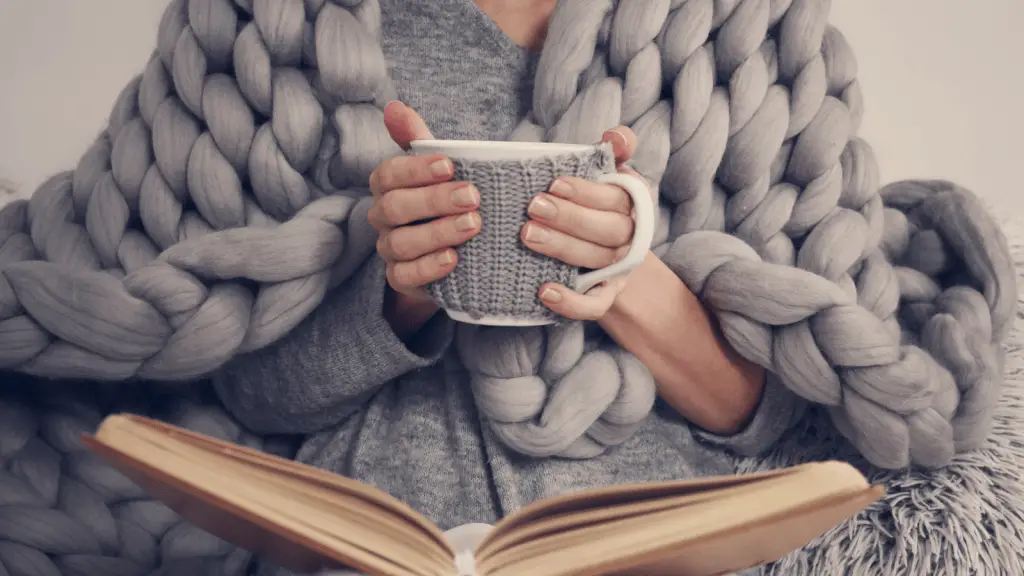
Header
It's All About The Wool
Not all needle felting wool is created equal and for anyone new to needle felting it can be frustratingly confusing. However, all you need is one or two good needle felting wools in your craft box to create a multitude of wonderful needle felting projects. This guide will take away all the painful confusion so you can get started instead of ruminating for hours over which wool is best for needle felting. I have kept it simple and tried to answer the most frequently asked questions. At the bottom of the post you will find my easy guide to wool and my personal favourites. You will see a lot of British wool on the list because, well I live in Britain so it makes sense to use what we have around us. If any shops or books are mentioned it is because I love their products and I highly recommend them. I am not affiliated to them in any way.
Let's get stuck in!
Did you know?
Worldwide, it is estimated there are 1000 distinct sheep breeds and around 60 of those are in Britain alone, more than anywhere else in the world. No wonder it's confusing! Read about the history of British wool HERE
My favourite, Herdwick Sheep on the Cumbrian Fells. They produce a very coarse wool top.
Header
Can all wool be needle felted?
Short answer is yes but some wool is much better suited to wet felting than needle felting, and vice versa. You will find my handy guide to needle felting wool at the bottom of this page.
Hands up if you're confused about core wool?
Core wool means different things to different people and that is where most of the confusion lies. Put simply, it just means the wool that you use for the centre or bulk of your project, and it can be any medium/coarse wool top or carded wool. Core wool is often used your top layer is going to be a different colour, or you are using a fine wool top layer, such as Merino. Core wool can be used to needle felt your basic shape and then covered with dyed wool. However, for many projects, it isn't necessary and if I am making a hare or a sheep then the whole thing will be made from natural Jacob, Shetland or Swaledale tops which are coarse and felt really easily. I will then add a few finishing touches and detail with a different colour wool, un-dyed where possible as I like the earthy, natural finish.
Where a different core wool is really useful is when you are creating life sized/larger animals, or using a more expensive, fine or dyed wool as your top colour. For example, birds, realistic animals, Christmas baubles, fruit, dragons, Easter eggs, solid gnome hats etc. These types of projects would be much easier to needle felt with a core of coarse wool and then covered with a top layer of bright Shetland, Corriedale, Merino.
Do I need Core Wool? It all depends on your project (see next section), and personal preference. Most of my animals are small (usually no bigger than 15-20cm) so I just use the same wool inside and out. It's much less of a faff and it stops the wool from a different colour core poking through the top layer. My preference is natural, medium to coarse wool top (sometimes called roving) for most of my animal projects and many of my needle felting kits. I usually encourage new felters to do the same, especially if they are going for a firm shape. For example, if I am making a grey hare or grey sheep then I will use my grey Jacob wool top, or similar, throughout only adding different wool for surface detail and contrast.
Header
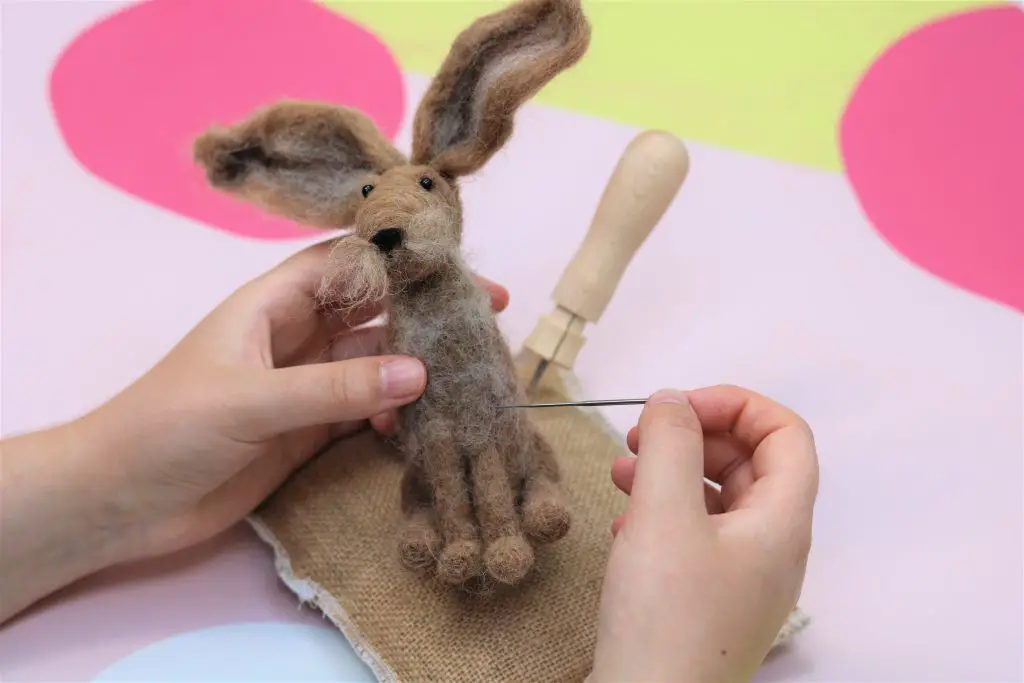

Header
Core wool for stuffing and wrapping soft sculpture
Another way to use core wool is, for soft sculpture and bigger rounder shapes. It is the perfect base for wrapping wool batting around to create pumpkins, garden bases , mushroom tops, bee hives and all manner of soft sculpture, where you want a particular look. They can be created in no time, are super simple and really effective. It can also be used for spinning and wrapping around a wire frame, although carded slivers (long lengths of carded wool) would work better for some armature projects.
Create a simple, soft shape from core wool (takes less than 5 minutes) and wrap the carded batt around it.
Shroom houses with a soft core garden base and roof. House is natural white Jacob top which needed to be much firmer.
![]()
Header

Life size Snowshoe Hare has a soft core of Shetland carded wool batts.
What is best, wool top or carded wool?
Now let's not put on the boxing gloves on this one. There is no right or wrong answer and it all depends on the wool you are using , what you are making and personal preference. The biggest problem is that a lot of people start their needle felting journey with Merino wool top, often in a kit, and use it for 3 dimensional projects which is just not suitable. It's is too fine, doesn't felt easily and makes the whole project hard work (more on Merino below). The poor newbie needle felter ends up thinking that they aren't good enough, or that needle felting is too hard and give up on needle felting altogether. So many 3 dimensional kits are created using Merino because the business has just thrown the kits together, with limited needle felting knowledge, poor instructions and not a great deal of thought for the end user.
Header
What is the difference between wool tops and carded wool?
Same wool, different processes.
Wool tops are made in long lengths (usually around the thickness of your wrist), quite dense with the fibres brushed in the same direction.
Carded wool fibres are much shorter and brushed in lots of different directions, resulting in a much loftier wool. You can buy them in long lengths or carded sheets.
Wool Tops (AKA roving)
A coarse wool top (often called roving) is a joy to work with, felts up quickly and easily and is really cost effective. I use it for almost all of my needle felted animals and in many of my needle felting kits. I love using it for these projects as I can get a very tight, firm shape in super quick time, and with few, if any, needle marks. I have been using coarse British wool tops since 2013 and love them as much now as I did then. You can find my handy guide to wool tops at the bottom of the page.

Carded wool bats (flat sheets) and carded slivers (long lengths)
Carded wool is also fabulous for needle felting and carded slivers (long legths) are ideal for working around a wire frame where the finished project tends to be much softer. I love using the long lengths when I am creating a project using a BBQ skewer; the needle felting tool you never knew you needed!
Header
Carded wool sheets (batting) are also perfect for wrapping around a core base to create lovely soft sculpture like the fox and mouse shown below, pumpkins, gnomes and larger life size pieces. The fox and mouse below were both created using a wire frame (armature) using carded batting sheets. Mouse is grey Jacob batting and fox is my own blend of Corriedale batting and wool top.
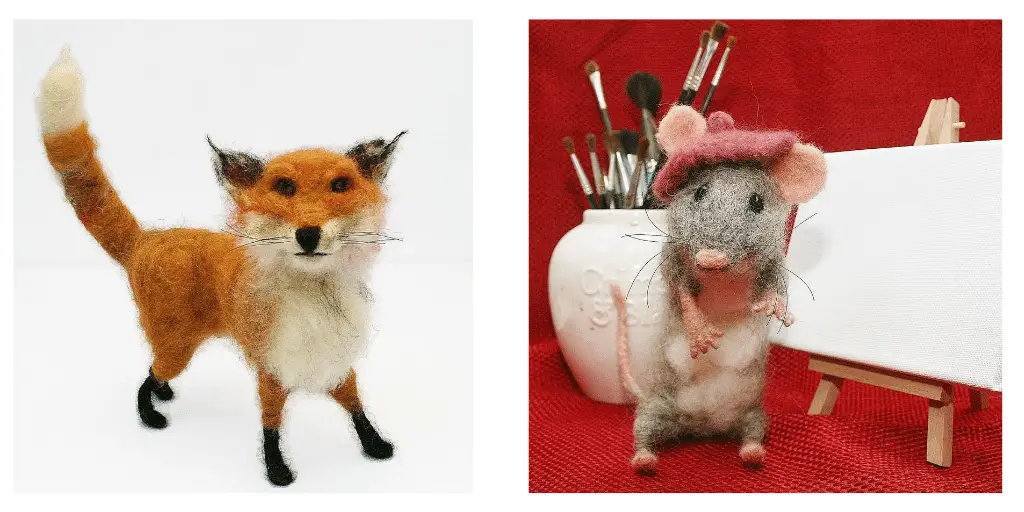
Pumpkins made using a lumpy core wool and covered with carded batting sheets.
![]()
Header
Hare made using carded lengths around a BBQ skewer - No wires![]()
Core wool for centre of pumpkins, wrapped with carded batting sheets. Finished by shaping with a felting needle and thin lines of wool tops.

Header

Pretty pastel pumpkin wreath and five minute macarons, both made using soft core wool and a top layer of carded wool.
![]()
Header
Are Merino wool tops any good for needle felting?
Not for three dimensional projects (use carded Merino instead) or anything with a lot of bulk that needs to be firmly felted. Merino is a beautiful wool, when used for the right application - especially wet felting, top coats, long animal fur and pictures - but I have lost count of new felters that have contacted me asking why their needle felting project isn't felting properly or is full of needle marks and is taking an age to shape. I can almost guarantee that they are using Merino or have started (as previously mentioned) with a needle felting kit that uses Merino. It saddens me when this happens because it is really disheartening to start a new craft, often with much trepidation, and not be able to complete it. It stops many new would be crafters in their tracks because they think their lack of know how is to blame. Such a confidence shaker and definitely a case of 'It's not you it's the wool' and I am at a bit of a loss as to why Merino is used in many needle felting kits?
Ethical Merino
I am often asked about Merino and the practice of mulesing. My advice is to check that any Merino you purchase is from a country that doesn't practice sheep mulesing; a horrible and painful practice used to control fly strike. The fly species that harms sheep is mostly an Australia and New Zealand problem so Merino from non-mulesed sheep is easy to get hold of. Notably South America, South Africa and Spain. My rule is if a supplier doesn't know where their Merino is from then I don't buy from them.
Curly wool/locks
Curly locks can be used for almost any project, to add texture and interest. Teesdale and Wensleydale are really popular and come in a raft of colours. You can also make your own out of knitting yarn. I must admit I am a bit of a curly locks hoarder and I like to open the drawers and just admire my stash; I know I'm not the only one who does this... There are lots of fabulous lock sellers online and I have popped a few of my faves below. Or, why not make your own with simple wool yarn. Click HERE for video tutorial.
Header

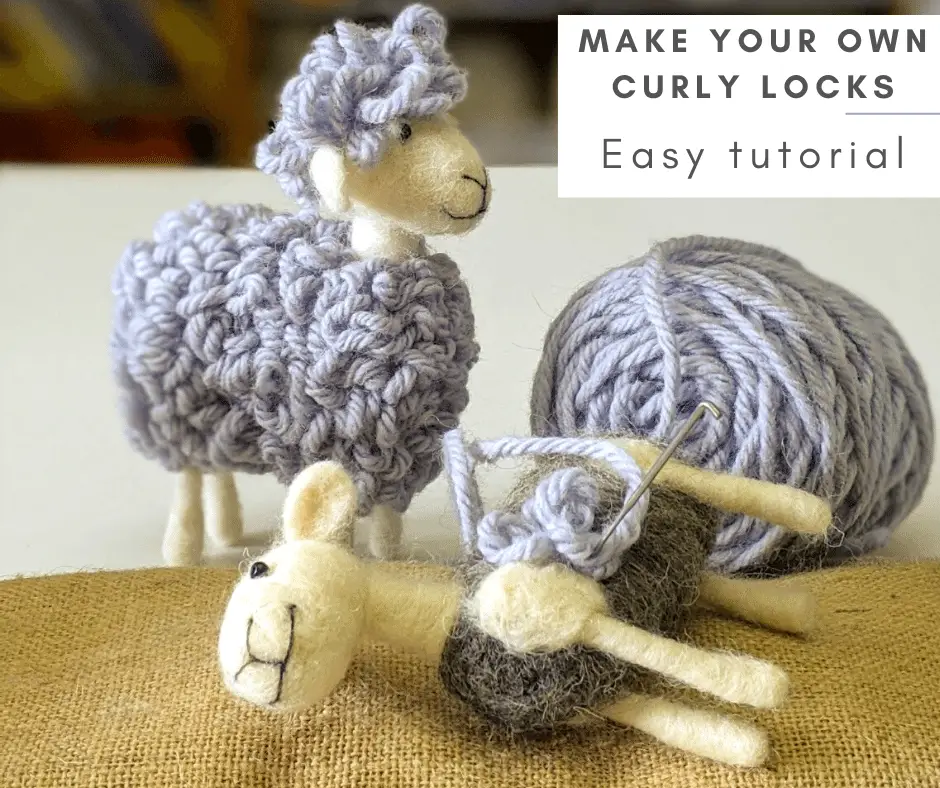
Header
Pre-Felt
If you want to create needle felted (or wet felted) pictures then pre-felt is the perfect base. Pre-felt is partially felted sheets of wool which are lightly carded and felted. It is stretchy and pliable and makes a great base for wet felted and needle felted pictures, allowing you to lay out and layer all your fibres on the top before wet felting or needle felting. You can make your own by wet felting a couple of layers of wool top or carded wool but is is also available to purchase online. My favourite is natural Shetland pre-felt which I add to my picture needle felting kits and use for my own projects. You can find it in my wool shop.

The possibilities for needle felted pictures are endless. I have added pearl beads and French knots to this one, called 'Asleep Under The Cherry Tree'.
Header
Angora and Alpaca
Too fine for bulky needle felting but, like Merino, good for blending with a coarser wool for different textures, wet felting and top coats.
What's the best wool for long animal fur
Anything that works, but especially wool tops, including Merino. My Herdwick sheep below have a long coat of Herdwick and the before and after results show how it is transformed. For all animals Merino and Corriedale are also really great choices. I spray mine with hairspray to keep everything in place. Some say it can discolour white wool, over time, but I have never found it to be an issue. CLICK FOR TUTORIAL How To Create Long Animal Fur?

Header
Created a lovely windswept look for this Highland Cow using Shetland wool tops. Carded wool for the nose and horns. Wire legs and Shetland wool top for the body.

Sustainable and ethical wool
It makes sense, wherever possible, to buy local or from the country you are in. The carbon foot print is reduced, you are supporting your community and the economy, and traceability is much easier. Much of our wool is from animals that are used for their wool and meat but that doesn't mean that they are not cared for and, for the overwhelming majority of farmers, animal welfare is a top priority. We do live in an imperfect world so there will always be rotten apples in the barrel. All my wool suppliers are British, family run businesses (some large some small) and I have never had a question on traceability or ethical farming go unanswered.
Header
Where does British wool fit into ethical and sustainable?

Quote from the British Wool website at: https://www.britishwool.org.uk/
"In global terms, UK sheep farms are small, having on average approximately 350 sheep. UK sheep are raised naturally outdoors on pasture. As a result, the scale and method of UK lamb production is such that it is not considered an ‘intensive’ farming activity by animal welfare campaigning bodies.
Sheep are required to be shorn of their wool once a year for their own comfort and health. Hence, wool is a naturally occurring by-product. Every year British Wool puts over 800 people in all parts of the UK through our two day shearing training courses that are tailored to their existing level of experience and skill. It goes without saying that shearing in accordance with best practice industry standards ensures that the process is stress free for the animal (as well as maximising the value of producers’ wool). Please visit our Shearing pages for further information. For further information, please email[email protected]or telephone 01274 688666."
Dyed wool
If you want to inject some colour into your projects then Shetland and Corriedale (a Merino Lincoln cross) are my favourites, but there is a huge range available and lately I have been looking for natural plant dyed wool which is not an easy task. These two dyed wools are ideal for any project that needs colour, be it landscapes, brightly coloured Christmas decorations or a vibrant topcoat. You can also blend colours to create different effects using your hands or a blending brush. If you don't have wool blending brushes, dog slicker brushes work really well.
Header
![]()
Can I use plant fibres for 3 dimensional needle felting?
You can but it's a struggle and a chore and the result isn't nearly as good as wool. Plant fibres, like bamboo, don't felt well because the fibres are much smoother, whereas wool has tiny scales that interlock when rubbed, agitated or compressed with a felting needle. A few years ago I put together a test 'vegetarian' needle felting kit, using only plant fibres, bamboo mostly. I then sent them out to a few customers for testing and each said that it was really difficult to work with and the end result was quite poor. Although plant fibres alone may not needle felt well they are still lovely to use for many other projects, especially when mixed with wool or added to finished wool projects. Bamboo, and especially silk tops add a lovely luxurious texture, contrast and sheen to your project. I use a lot of silk in needle felted pictures, on pumpkins and gnome beards and hats.
Can I buy vegetarian wool?
You can and availability is increasing. Vegetarian wool, also called slaughter free wool, means that the when the animal dies it is not sent to slaughter and does not end up in the food chain. I love the organic, vegetarian wool from the Doulton Border Leicester flock. It is a lovely coarse British breed wool that felts beautifully. Ellie refers to them as 'sheep that live to grow old' and even has a seperate area for her OAP sheep. You can find her on ETSY or via her WEBSITE and she also sells the most gorgeous vegetarian knitting yarn. I use Ellie's wool in my vegetarian needle felting kit and punch needle kits.
Header
Can wool be over felted?
Definitely. The more you needle felt the more you are breaking down the wool fibres. If you over felt, by repeatedly poking the wool in the same spot for too long, the fibres will eventually break down and start to go soft. If this happens it is best to start again with fresh wool.
What do I need to start needle felting?
Only four things are needed and you are good to go;
- Good quality wool
- Felting needle; size 38 or 36 to start with. Both are good all rounders. European needles are the best.
- Soft but firm felting base of either foam, wool or a hessian bag filled with rice.
- Enthusiasm
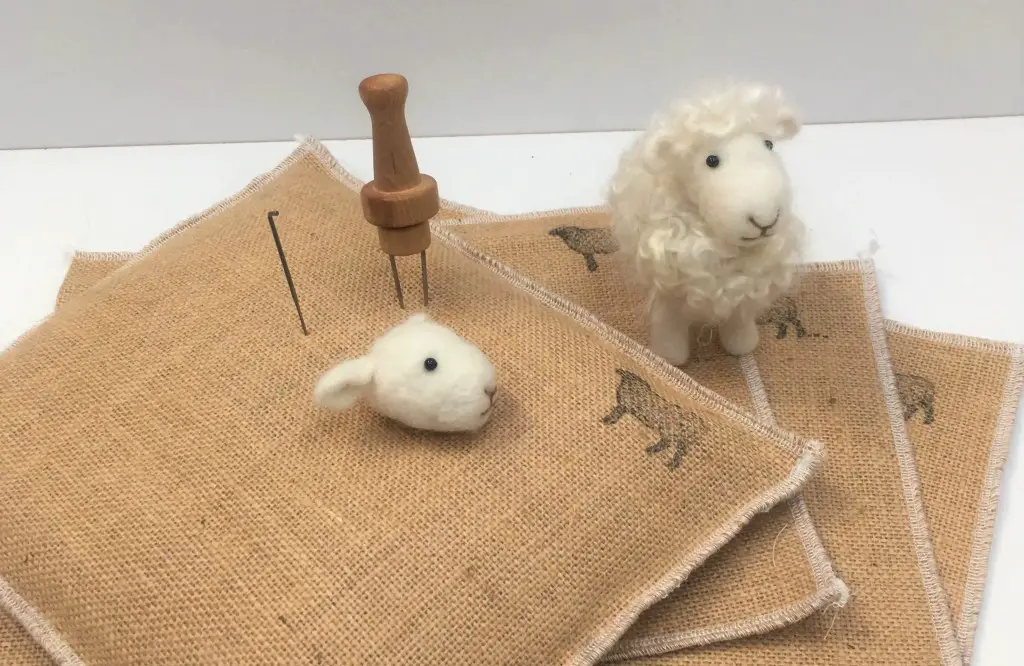
My GUIDE TO FELTING NEEDLES can be found HERE
Header
Wool Guide At a glance - My needle felting wool guide in a handy chart
This chart is so useful and if you are ever unsure whether a wool is suitable for needle felting then just look at the micron count. This is the measurement used to determine how fine or coarse the wool is. The lower the micron number the finer the wool. For example: Jacob is 33-35 microns - coarse and perfect for needle felting. Whereas Merino is 23 microns, fine and not so good. Most of my animal needle felting kits use Jacob, Shetland or Swaledale. Of course, as you become more confident, you will develop your own preferences and the best way is to try a few yourself. Here are some of the most popular (although not exclusively) in a handy chart.
My favourites are marked with *
Header
| WOOL | ORIGIN | TEXTURE | MICRON | GOOD FOR NEEDLE FELTING |
|---|---|---|---|---|
| Jacob * | England | Coarse | 25-35 | Yes. Earthy finish |
| Shetland* | Scotland | Medium/ Coarse | 25-30 | Yes |
| Swaledale* | Northern England | Very Coarse | 36-40 | Yes - slightly wiry finish |
| Herdwick | North West England | Very Coarse | 36-40 | Yes - very wiry finish |
| Corriedale (Merino and Lincoln cross) | New Zealand | Fine/ Medium | 25-30 | OK - needs more work. Good for topcoats, pictures, wet felting and blending. |
| Merino | Spain | Fine Super Fine | 23 18 | No - best blended with coarser wool. Good for topcoats, pictures, wet felting and blending. |
| White* Faced Woodland | England | Coarse | 28-38 | Yes |
| Masham | Coarse | 34-38 | Yes - Smooth finish. Quite slippery. | |
| Blue Faced Leicester | Fine | 24-28 | Somewhat - smooth finish. More visible needle marks. | |
| Border* Leicester | Northern England | Coarse | 30-40 | Yes - smooth finish |
| Manx Loaghtan | Isle Of Man | Medium/ Coarse | 27-33 | Yes |
| Lincoln Longwool | England | Coarse | 33-45 | Yes |
| Teeswater | England | Coarse | 30-36 | Yes - smooth finish |
| Alpaca | South America | Fine | 26 | No |
| Gotland | Sweden | Medium/ Coarse | 27-35 | Yes |
| Texel* | Netherlands | Medium/ Coarse | 26-26 | Yes |
| Norweigian | Norway | Coarse | 28-35 | Yes |
Header
How do I know what wool top I am using?
If you are new to needle felting and handling wool you probably won't be able to tell. It's easy for me as I have been handling wool for a long time and can even name some of the sheep breeds by running the wool through my hands. If you are finding it difficult to needle felt, and it feels smooth and silky, the chances are it is a Merino or other fine wool with a low micron count.
And Finally...almost. Don't miss the really useful stuff below!
This is just a guide to impart some of the knowledge I have gained over the last seven years but I hope it helps you in your felting journey. Just experiment and have fun because there really is no right and wrong. Many people start with a needle felting kit which usually has everything you need to complete your first project. Just try not to start with one that uses Merino as it will make the learning curve harder. All my felting kits, wool and accessories are available on the LFC website HERE
On this blog - really useful links and tutorials
Getting Started: Do’s And Don’ts
How to needle felt a firm head shape
Types of wool and how to use them - video tutorial
Header
